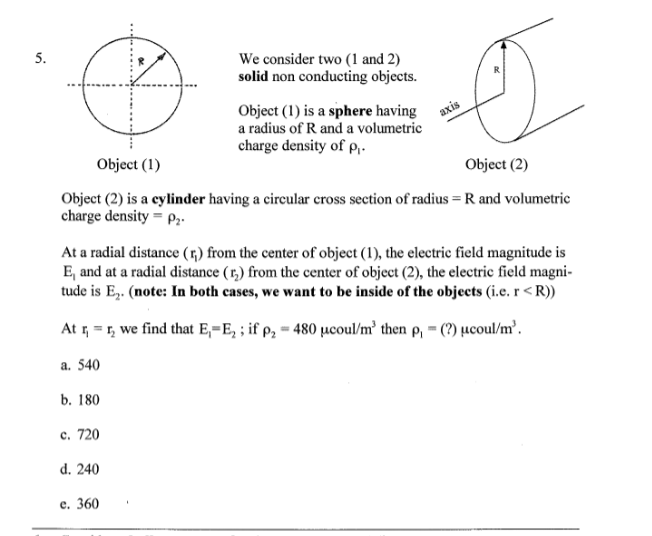5. We consider two (1 and 2) solid non conducting objects. Object (1) is a sphere having a radius of R and a volumetric charge density of p,- axis Object (1) Object (2) Object (2) is a cylinder having a circular cross section of radius = R and volumetric charge density = P,- At a radial distance (r,) from the center of object (1), the electric field magnitude is E, and at a radial distance ( r;) from the center of object (2), the electric field magni- tude is E. (note: In both cases, we want to be inside of the objects (i.e. r < R))
5. We consider two (1 and 2) solid non conducting objects. Object (1) is a sphere having a radius of R and a volumetric charge density of p,- axis Object (1) Object (2) Object (2) is a cylinder having a circular cross section of radius = R and volumetric charge density = P,- At a radial distance (r,) from the center of object (1), the electric field magnitude is E, and at a radial distance ( r;) from the center of object (2), the electric field magni- tude is E. (note: In both cases, we want to be inside of the objects (i.e. r < R))
Physics for Scientists and Engineers, Technology Update (No access codes included)
9th Edition
ISBN:9781305116399
Author:Raymond A. Serway, John W. Jewett
Publisher:Raymond A. Serway, John W. Jewett
Chapter24: Gauss’s Law
Section: Chapter Questions
Problem 24.46P: A thin, square, conducting plate 50.0 cm on a side lies in the xy plane. A total charge of 4.00 108...
Related questions
Question

Transcribed Image Text:5.
We consider two (1 and 2)
solid non conducting objects.
Object (1) is a sphere having
a radius of R and a volumetric
charge density of p,-
axis
Object (1)
Object (2)
Object (2) is a cylinder having a circular cross section of radius = R and volumetric
charge density = P,-
At a radial distance (r,) from the center of object (1), the electric field magnitude is
E, and at a radial distance ( r;) from the center of object (2), the electric field magni-
tude is E. (note: In both cases, we want to be inside of the objects (i.e. r < R))
Expert Solution
This question has been solved!
Explore an expertly crafted, step-by-step solution for a thorough understanding of key concepts.
Step by step
Solved in 5 steps with 5 images

Knowledge Booster
Learn more about
Need a deep-dive on the concept behind this application? Look no further. Learn more about this topic, physics and related others by exploring similar questions and additional content below.Recommended textbooks for you

Physics for Scientists and Engineers, Technology …
Physics
ISBN:
9781305116399
Author:
Raymond A. Serway, John W. Jewett
Publisher:
Cengage Learning

Principles of Physics: A Calculus-Based Text
Physics
ISBN:
9781133104261
Author:
Raymond A. Serway, John W. Jewett
Publisher:
Cengage Learning

College Physics
Physics
ISBN:
9781285737027
Author:
Raymond A. Serway, Chris Vuille
Publisher:
Cengage Learning

Physics for Scientists and Engineers, Technology …
Physics
ISBN:
9781305116399
Author:
Raymond A. Serway, John W. Jewett
Publisher:
Cengage Learning

Principles of Physics: A Calculus-Based Text
Physics
ISBN:
9781133104261
Author:
Raymond A. Serway, John W. Jewett
Publisher:
Cengage Learning

College Physics
Physics
ISBN:
9781285737027
Author:
Raymond A. Serway, Chris Vuille
Publisher:
Cengage Learning

College Physics
Physics
ISBN:
9781305952300
Author:
Raymond A. Serway, Chris Vuille
Publisher:
Cengage Learning

Physics for Scientists and Engineers
Physics
ISBN:
9781337553278
Author:
Raymond A. Serway, John W. Jewett
Publisher:
Cengage Learning

Physics for Scientists and Engineers with Modern …
Physics
ISBN:
9781337553292
Author:
Raymond A. Serway, John W. Jewett
Publisher:
Cengage Learning